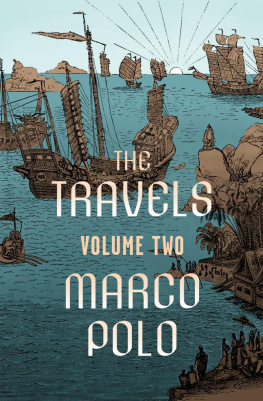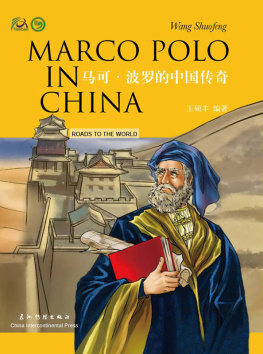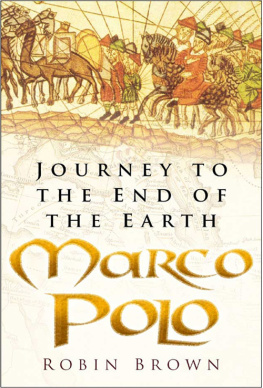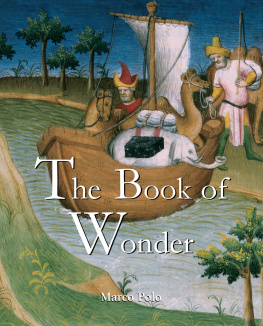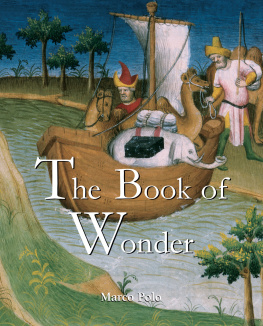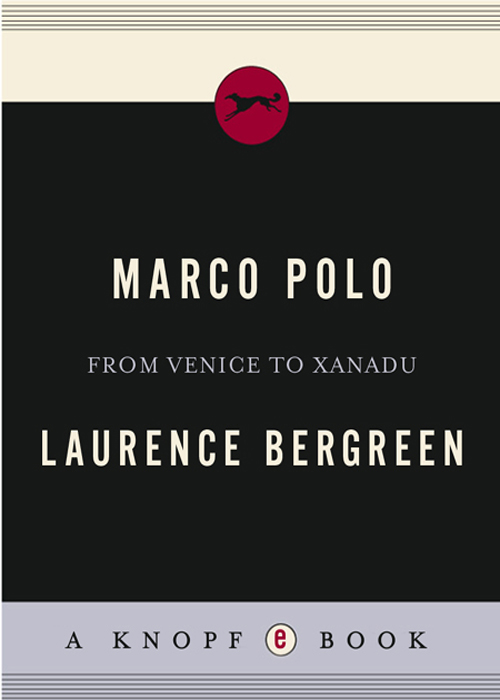
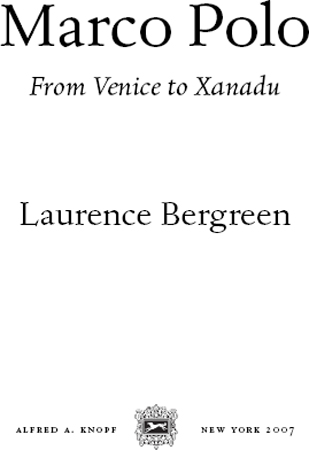
CONTENTS
To my mother,
Adele Gabel Bergreen
Kublai asks Marco, When you return to the West, will you repeat to your people the same tales you tell me?
I speak and speak, Marco says, but the listener retains only the words he is expecting. The description of the world to which you lend a benevolent ear is one thing; the description that will go the rounds of the groups of stevedores and gondoliers on the street outside my house the day of my return is another; and yet another, that which I might dictate late in life, if I were taken prisoner by Genoese pirates and put in irons in the same cell with a writer of adventure stories. It is not the voice that commands the story: it is the ear.
And I hear, from your voice, the invisible reasons which make cities live, through which perhaps, once dead, they will come to life again.
Italo Calvino, Invisible Cities
DRAMATIS PERSONAE
WEST
Marco Polo, Venetian merchant
Niccol Polo, Marcos father
Maffeo Polo, Marcos uncle
Teobaldo of Piacenza, papal legate; later Pope Gregory X
Rustichello of Pisa, Marcos cell mate in Genoa and coauthor
EAST
Genghis (or Chinggis) Khan, founder of the Mongol Empire
gdei Khan, Genghiss son and successor
Kublai Khan, one of Genghiss grandsons; the Great Khan of the Mongols
Mngke Khan, one of Genghiss grandsons
Sorghaghtani Beki, mother of Mngke, Hleg, and Kublai
Chabi, Kublais principal wife, a Buddhist
Ahmad, Kublais Muslim minister of finance
Nayan, Kublais Christian rival
Arigh Bkh, younger brother of Kublai Khan
Kaidu, one of Kublais cousins
Phags-pa, Tibetan Buddhist monk who devised a uniform Mongol script
Bayan Hundred Eyes, Kublai Khans trusted general
PROLOGUE
The Commander
I N THE SUMMER OF 1298, Genoas navy, one of the most powerful in Europe, gathered forces for an assault on the fleet of the Most Serene Republic of Venice. Despite formal truces, these two adversaries had been doing battle for decades, vying for lucrative trade routes to the East.
Crafty and bold, Genoa usually enjoyed the upper hand in their bloody contests. In 1294, the Genoese had won a naval action by lashing their vessels together in an enormous square. When the Venetians attacked, the floating fortress shattered the would-be invaders and put them to flight. The following year, the Genoese again demonstrated dominance of the high seas by sinking the principal Venetian trading fleet, and when they ran out of targets on the water, they pursued the Venetians on land. In 1296, in Constantinople, the Genoese massacred their rivals, acquiring a reputation for cruelty and rapacity.
Venice gradually rallied. Under the leadership of daring naval commanders, sleek Venetian galleys pursued the Genoese wherever they went, setting the stage for the Battle of Curzola, named for an island along the craggy Dalmatian coast, claimed by both of these arrogant city-states in their incessant maritime trade wars.
THE IMMENSE Genoese fleet, eighty-eight ships in all, sailed under the confident command of newly appointed admiral Lamba Doria, who pursued a wait-and-see strategy, hiding behind islands, then sailing into warmer waters close to Tunisia, hoping to lure the impatient Venetians into his grasp. The Venetians refused the bait, and the forces of Genoa had to content themselves with random local skirmishes. Finally, Admiral Doria could wait no more, and he ordered his fleet north, into the Gulf of Venice. The ships met with no significant resistance as they sailed past cities and castles under nominal Venetian control. In the absence of the enemy, they dropped anchor off the coast of Curzola, four hundred miles southeast of Venice. At that moment, a violent storm claimed six of the fleets eighty-eight vessels, and when it cleared, the survivors proceeded to loot and destroy the island, offering what they assumed would be an irresistible taunt to the invisible Venetians.
On the morning of September 6, 1298, amid gathering heat and humidity, the Venetian fleet suddenly appeared out of the mist: ninety-six galleys under the command of Andrea Dandolo, the scion of a prominent dynasty. The Venetian galleys, renowned for their speed, were slender, elegant affairs resembling giant gondolas, powered by pairs of straining oarsmen. The galleys could plunge into oncoming waves and, with equal confidence, turn to drive a spur projecting from the bow into an opposing ship. The moment this device was in place, Venetian forces rushed across to storm the enemy.
Because oars work most efficiently when they enter the water at a shallow angle, the ships exposed less than three feet of freeboard. (Galleys could also travel under sail, although they were poorly equipped for this technology.) Existence aboard a Venetian galley was misery. Crews of about a hundred men were crowded into narrow spaces; food and water were in short supply. Galleys carried only a weeks worth of supplies; short rations for the exhausted rowers were the norm rather than the exception. To cope with these severe limitations, Venetian galleys put in at night, and kept their missions briefthree or four days, at most. With their shallow drafts, they hugged the shoredeadly but surprisingly vulnerable craft lying in wait to strike.
ONE OF THESE ships was commanded by Marco Polo, a merchant who had returned from China three years earlier. At forty-four, he was among the oldest participants in the battle, and by far the best traveled. Marco headed into battle bearing the title of noble of Venice, financing his own ship and relying on experienced pilots to do the actual sailing. A global traveler since the age of seventeen, he felt most at home when abroad. Under siege, Marco Polo was in his element, confident and composed. Fighting in the Battle of Curzola was a way to surround himself with glory in the eyes of his fellow Venetians, who regarded his tales of China with skepticism.
Andrea Dandolo led Marco and the other Venetians to the opposite side of Curzola, where his men disembarkedand promptly went into hiding. During the interlude, Lamba Doria had taken the measure of the enemy fleet, and had reached the erroneous conclusion that the Venetians were simply delaying engagement in battle out of fear. But the next morningSunday, September 8the Venetians charged across Curzola toward the Genoese encampment.
Eager to confront the Venetians at last, Doria led his men into an amphibious battle. On land, arrows darkened the skies; at sea, galleys rammed and set fire to one another.
As Doria surveyed the scene at the height of battle alongside his son Ottavio, a Venetian arrow struck the young man in the chest. Ottavio fell at his fathers feet, suddenly lifeless. Others aboard the ship attempted to commiserate with Doria, but he refused their pity. Throw my son overboard into the deep sea, he ordered. What better resting place can we give him than this spot?
With the wind at their backs, the Venetians, under Dandolos leadership, seized the initiative and captured ten Genoese galleys, but in their enthusiasm they ran their ships aground. After nine hours of combat, the exhausted Venetians found themselves overwhelmed. The Genoese captured eighty-four Venetian galleys, sinking some and burning others to the waterline. Only a handful of the once-proud vessels escaped. The human toll proved even greater. In all, the Genoese forces captured 8,000 mena breathtaking number at a time when the total population of Venice was scarcely 100,000. The defeat amounted to the worst setback that Venice had suffered during a decade of battles with Genoa.
Next page

